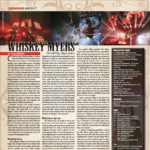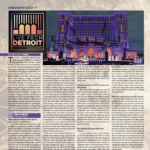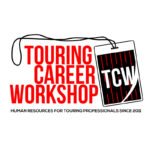
Up-and-coming musical sensation Benson Boone has been out on his Fireworks & Rollerblades World Tour that features the work of Production Designer, Mitchell Schellenger of Station Six and Lighting Designer Jason Rothberg. The two designers took some time with PLSN to share some insight into their design, which had to expand for three bigger arena shows in Salt Lake City, Phoenix, and LA.
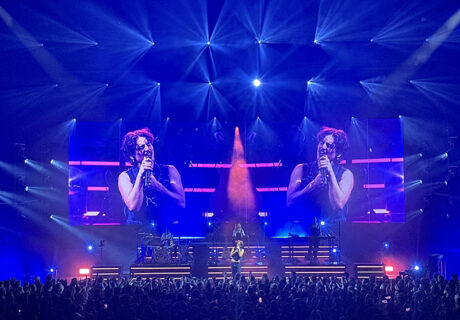
Mitchell, what was the design aesthetic you were going for the tour?
Schellenger: I wanted to give him some real estate just to run around; he’s a 21-year-old kid. That was the only parameter—‘room to move.’ He loves to rollerblade. I mean, the tour is called Fireworks & Rollerblades. So that kind of tells you what type of person he is. He’s very active on stage. In smaller theaters, we don’t have a ton of real estate, but we could at least give him height. I knew bringing height into play was going to be critical. We thought about doing ramps, but we knew it was one truck, and no dedicated carp. We wanted to keep it simple.
We made some light box risers that we could put the band on, to give them some height. We gave him another level behind, so he can jump up and down, or jump between them. He literally does back flips off the risers—his feet land about 2” from the downstage edge. Aesthetically, I get an ‘80s, ‘90s vibe from listening to his music and from the tour branding and merch. I wanted to do something with stripes to tie into that vibe. We knew we didn’t have the time to do a ton of scenic customization, so we had our friends at Volt, through their division—Solid Industries, fabricate riser facias with Sceptrons laid into them. The risers were provided by All Access, which again was a last-minute call, so we appreciate All Access jumping on it as quickly as they did and were able to make this all happen. While it’s a lighting element, the diffused Sceptrons did give the riser fascia some flavor. We thought about doing a backdrop but liked the negative space and letting him be the star up there. Keep it clean and simple.
For the main tour we had no video. He’s new to doing shows, especially sizable shows, so there’s no screen content package, yet. As we start doing television performances, we’re starting to build content into the mix. But for the three arena dates since we brought a video wall to fulfill the needs of rooms that size, we really leaned into just I-Mag with Notch, which I think worked well for him. We added more lights for the arena shows as well.
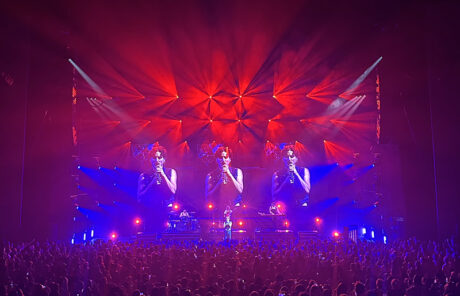
Talk about your lighting design, Jason.
Rothberg: For the base tour, we had just one truck that had to handle everything. The Volt guys knocked it out of the park with how it’s prepped; everything rolls in on booms or little 5’ truss towers. There’s only a handful of fixtures that need to be placed individually. We knew we couldn’t rely on house rigs in some venues, so we wanted to make sure the show could stand on its own without having to use anything. We wanted to give it a theatrical feel to it, which is why there’s six booms—’Benson Booms’ as we call them. A set mid- and downstage just to give a lot of sidelight and color to the show and then punch through with some profile fixtures.
The workhorse light was probably the Elation DTW Blinder, which is like a two light Mole for that tungsten sidelight feel, as well as for some backlight hits behind Benson and each band member. Then the [Ayrton] Diablos give us a ton of texture and beamage behind everyone. Some nice beams and gobo looks; a lot of audience fly-outs. The Diablos are the main key lights for Benson as well, and a set of Diablos down left as a low side key light. That light has a small form factor but holds up well even in the big theaters and its zoom range is pretty good. For the smaller venues we play, you need more zoom, especially with the downstage stuff. We had a week’s notice for this design, so a lot of our choices came down to what we could get, but I think we pretty much got most of our original asks. Volt is such a great vendor and has a dynamic list of options. I don’t feel we had to compromise.
Why was Volt the right company for this tour?
JR: We have a good working relationship with them. We knew we needed a package that could be compact and fit into a truck and be prepped well. They always knock all that kind of stuff out of the park. They also have a fabrication shop, so if we knew we needed any sort of custom pieces to really make those booms or towers work, or anything to be rolling, they had everything we needed for that. And the gear’s always top notch when it comes out of their shop.
What’s something you think others in the industry might say about the design?
MS: I think they’d say, ‘they really gave this young, talented musician a punchy show that makes sense for the scalability of the rooms.’ That was another challenge; some of the theaters were small and then some had an 80’ proscenium opening. So, we knew we needed some ability to expand and contract everything from the risers to the lighting. That’s another reason we did this modular riser package. We can have them all kissing each other with no space between them, or we could also put a 10’ gap between them all and it all still makes sense. Just having the ability to do this everywhere, I think I would hope people would say they created something that can really showcase the artist and his talents in a clean modular fashion.
What’s something you’d call out to a designer about this show?
JR: Pay attention to the cueing and how it’s just all the right moments that are hit. It’s not overly flashy. I hope all the right moments are highlighted appropriately. It’s a simple, really small package as a whole, but I think it looks much bigger than it really is.
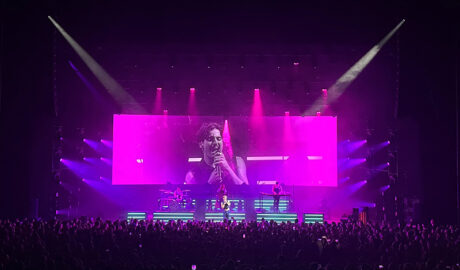
PRODUCTION TEAM
- Tour Manager: Adam Carr
- Production Manager: Joey Diehl
- Production Designer: Mitchell Schellenger
- Lighting Designer: Jason Rothberg
- Lighting Programmer: PJ Carruth
- Lighting Director: Reid Semmens
VENDORS
- Lighting: Volt, Craig Caserta, Matt Shimamoto
- Scenic Fabrication: Solid Industries, Aaron Cook, Matt Shimamoto
- Video: Fuse Technology Group, Patrick Eaton, Shayne Stalnaker
- Risers: All Access, Robert Achlimbari
GEAR
Base Tour
Lighting
- 14 Ayrton Diablo
- 15 CHAUVET COLORado PXL Bar 16
- 11 Elation DTW Blinder 350
- 12 GLP impression X4
- 12 GLP JDC-1 Hybrid Strobe
- 42 Martin VDO Sceptron 10 1000mm
- 16 Martin VDO Sceptron 10 320mm
- 2 Master FX Mystic Hazer
- 1 grandMA2 full-size Console
Arena Adds (3 Shows), Production Team:
- Lighting Crew Chief: Jason Bielsker
- Lighting Tech: Sam Tepper
- Video Director: Zac Leonard
- Visuals Operator: Bethany Mudrick
- Video Engineer: John Lawrence Johnson III
- Video Crew Chief: John Bowman
- Video Tech/Cameras: Michael Shaw, Aaron Walchli
Arena Adds, Gear:
Lighting
- 30 Elation Fuze MAX Profile
- 18 Elation Artiste Rembrandt
- 16 Elation DTW Blinder 350
- 30 GLP impression X5
- 10 GLP impression X4
- 25 GLP JDC-1 Hybrid Strobe
- 3 Robe FORTE Followspot
- 4 Master FX Mystic Hazer
- 1 grandMA3 full-size Console
- 25 Tyler Truss GT 10’ Truss
- 26 CM 1 Ton Motor
Video
- 104 ROE Visual CB5 Full LED Panel
- 4 Panasonic AK-UC4000 Camera
- 2 Panasonic UE150 PTZ Camera
